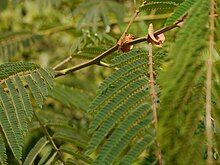Comments
provided by eFloras
Often cultivated as a shade tree; wood is used for planks. In some parts of India and Ceylon this species is used for fodder. The amount of nitrogen in the soil is increased by the presence of symbiotic bacteria on the roots.
- license
- cc-by-nc-sa-3.0
- copyright
- Missouri Botanical Garden, 4344 Shaw Boulevard, St. Louis, MO, 63110 USA
Description
provided by eFloras
A deciduous tree, bark grey, nearly smooth, young parts hairy. Leaves bipin¬nate, stipules c. 2.5 cm long, obliquely cordate, rachis c. 15-30 cm long having a large gland about 2.5 cm from the base, pinnae 7-20 pairs, 5-15 cm long, leaflets 20-45 pairs, more or less sessile, linear-oblong, falcate, subacute at the apex, trun¬cate at the base, c. 1.3-2.6 cm long and c. 2.5 mm broad, glabrous above, pilose on margin and midrib below; midrib close to the upper edge; small glands between the upper pairs of pinnae. Inflorescence peduncled heads, 1-4 together, arranged in small axillary or terminal panicles; peduncle c. 1.75-3 cm long. Flowers yellowish, pedicels very short or absent, bracteate; bracts ovate, acuminate, deciduous, c. 1. 25 cm long. Calyx tubular, 2.5 mm long, teeth acute, corolla c. 5-6 mm long, hairy outside, lobes c. 2.5-3 mm long. Stamens forming a tube at the base, 2.5-3.3 cm long, staminal tube longer than the corolla tube. Pods c. 10-17.5 cm long, c. 1.3-1.8 cm broad, thin, glabrous, light brown, minutely punctate. Seeds 8-12.
- license
- cc-by-nc-sa-3.0
- copyright
- Missouri Botanical Garden, 4344 Shaw Boulevard, St. Louis, MO, 63110 USA
Distribution
provided by eFloras
Himalaya, India, Ceylon, S.E. Asia, Malaysia, China.
- license
- cc-by-nc-sa-3.0
- copyright
- Missouri Botanical Garden, 4344 Shaw Boulevard, St. Louis, MO, 63110 USA
Distribution
provided by eFloras
Distribution: W. Pakistan, Lower Kagan, Jhelum, Kishenganga valleys, eastward up to 4000 ft.; India (Punjab, Uttar Pradesh, Bengal, Bombay, Madras; Asam, Sikkim), Ceylon, Nepal, Bhutan, Burma, Southern China, South East Asia, Philippine, Java.
- license
- cc-by-nc-sa-3.0
- copyright
- Missouri Botanical Garden, 4344 Shaw Boulevard, St. Louis, MO, 63110 USA
Derivation of specific name
provided by Flora of Zimbabwe
chinensis: of China
- license
- cc-by-nc
- copyright
- Mark Hyde, Bart Wursten and Petra Ballings
- bibliographic citation
- Hyde, M.A., Wursten, B.T. and Ballings, P. (2002-2014). Albizia chinensis (Osbeck) Merr. Flora of Zimbabwe website. Accessed 28 August 2014 at http://www.zimbabweflora.co.zw/speciesdata/species.php?species_id=125630
- author
- Mark Hyde
- author
- Bart Wursten
- author
- Petra Ballings
Frequency
provided by Flora of Zimbabwe
Local
- license
- cc-by-nc
- copyright
- Mark Hyde, Bart Wursten and Petra Ballings
- bibliographic citation
- Hyde, M.A., Wursten, B.T. and Ballings, P. (2002-2014). Albizia chinensis (Osbeck) Merr. Flora of Zimbabwe website. Accessed 28 August 2014 at http://www.zimbabweflora.co.zw/speciesdata/species.php?species_id=125630
- author
- Mark Hyde
- author
- Bart Wursten
- author
- Petra Ballings
Worldwide distribution
provided by Flora of Zimbabwe
Native to South and Southeast Asia.
- license
- cc-by-nc
- copyright
- Mark Hyde, Bart Wursten and Petra Ballings
- bibliographic citation
- Hyde, M.A., Wursten, B.T. and Ballings, P. (2002-2014). Albizia chinensis (Osbeck) Merr. Flora of Zimbabwe website. Accessed 28 August 2014 at http://www.zimbabweflora.co.zw/speciesdata/species.php?species_id=125630
- author
- Mark Hyde
- author
- Bart Wursten
- author
- Petra Ballings
Physical Description
provided by USDA PLANTS text
Perennial, Trees, Woody throughout, Nodules present, Stems erect or ascending, Stems greater than 2 m tall, Stems solid, Stems or young twigs sparsely to densely hairy, Leaves alternate, Leaves petiolate, Extrafloral nectary glands on petiole, Stipules conspicuous, Stipules green, triangulate to lanceolate or foliaceous, Stipules deciduous, Stipules free, Stipules cordate, lobed, or sagittate, Leaves compound, Leaves bipinnate, Leaf or leaflet margins entire, Leaflets opposite, Leaflets 10-many, Leaves glabrous or nearly so, Inflorescence panicles, Inflorescence umbel-like or subumbellate, Inflorescences globose heads, capitate or subcapitate, Inflorescence terminal, Flowers actinomorphic or somewhat irregular, Calyx 5-lobed, Calyx glabrous, Petals united, valvate, Petals ochroleucous, crea m colored, Petals greenish yellow, Stamens numerous, more than 10, Stamens long exserted, Filaments glabrous, Style terete, Fruit a legume, Fruit unilocular, Fruit indehiscent, Fruit elongate, straight, Fruit oblong or ellipsoidal, Fruit or valves persistent on stem, Fruit exserted from calyx, Fruit compressed between seeds, Fruit glabrous or glabrate, Fruit 3-10 seeded, Seed with elliptical line or depression, pleurogram, Seeds ovoid to rounded in outline, Seed surface smooth, Seeds olive, brown, or black.
Albizia chinensis: Brief Summary
provided by wikipedia EN
Albizia chinensis is a species of legume in the genus Albizia, native to south and Southeast asia, from India to China and Indonesia.
The genus is named after the Italian nobleman Filippo degli Albizzi, belonging to the famous Florentine family Albizzi, who introduced it to Europe in the mid-18th century, and it is sometimes incorrectly spelled Albizzia.

Seed of Albizia chinensis

Albizia chinensis leaves
- license
- cc-by-sa-3.0
- copyright
- Wikipedia authors and editors


 Seed of Albizia chinensis
Seed of Albizia chinensis  Albizia chinensis leaves
Albizia chinensis leaves